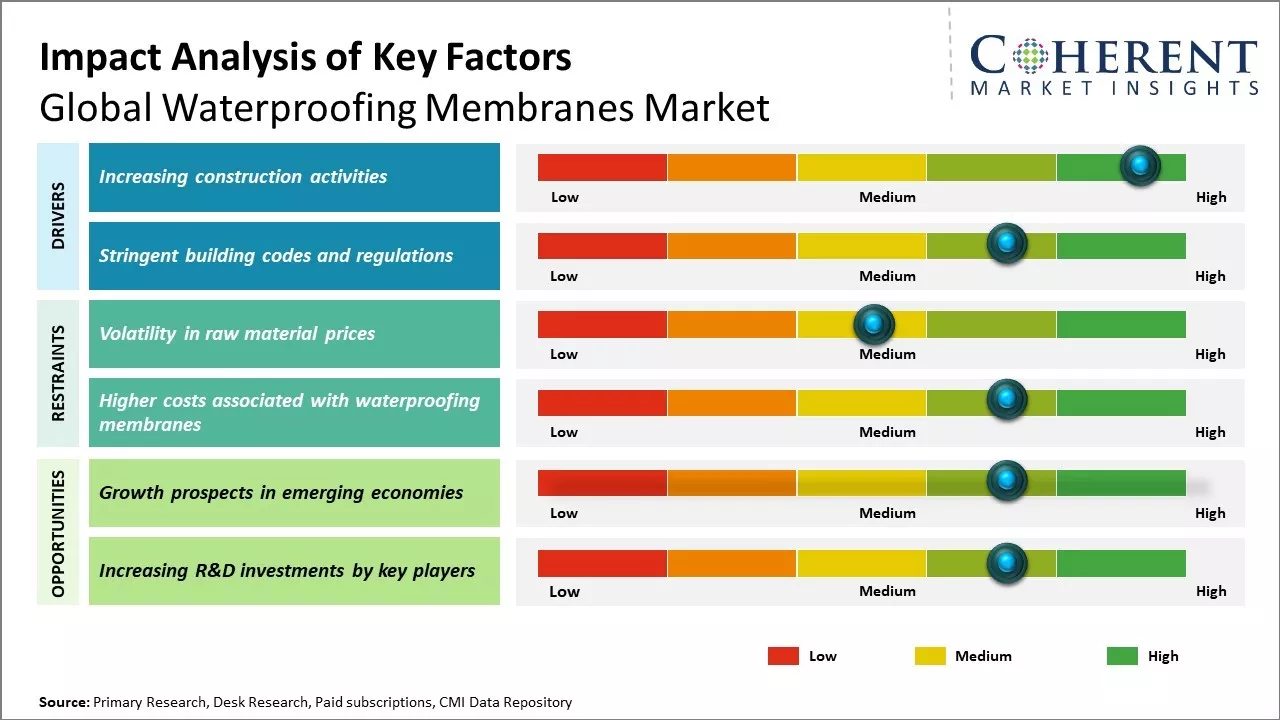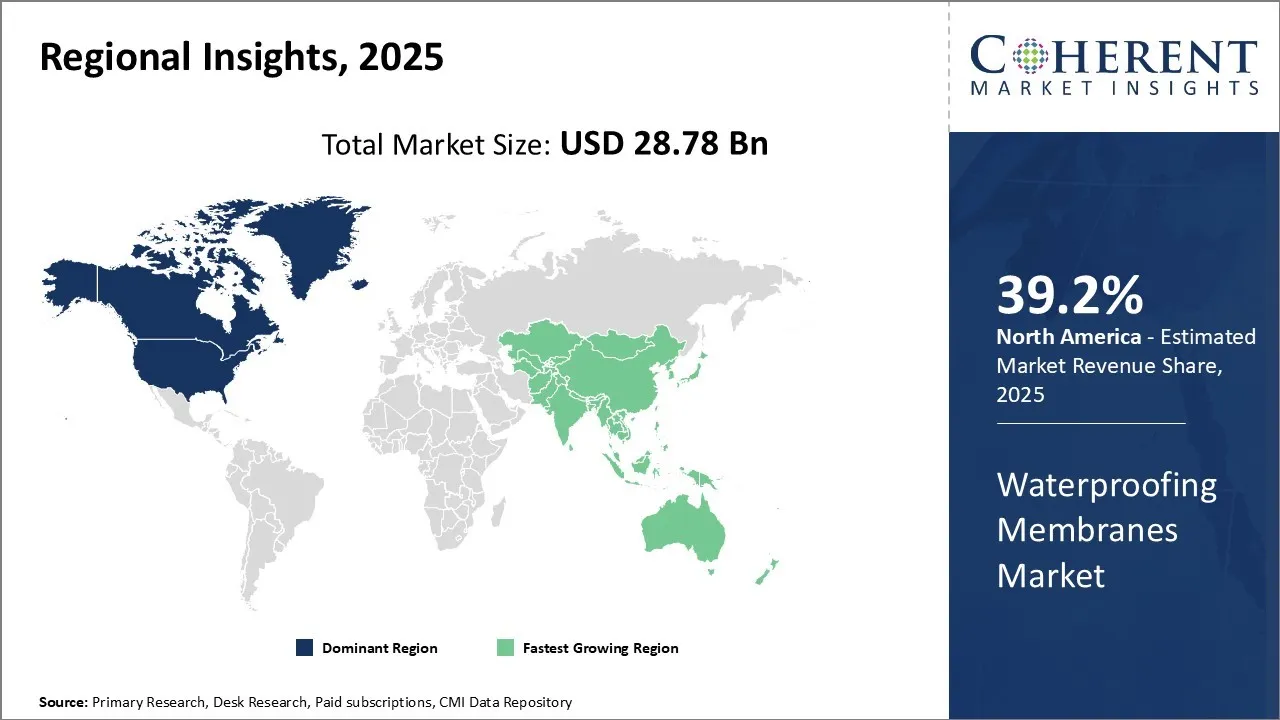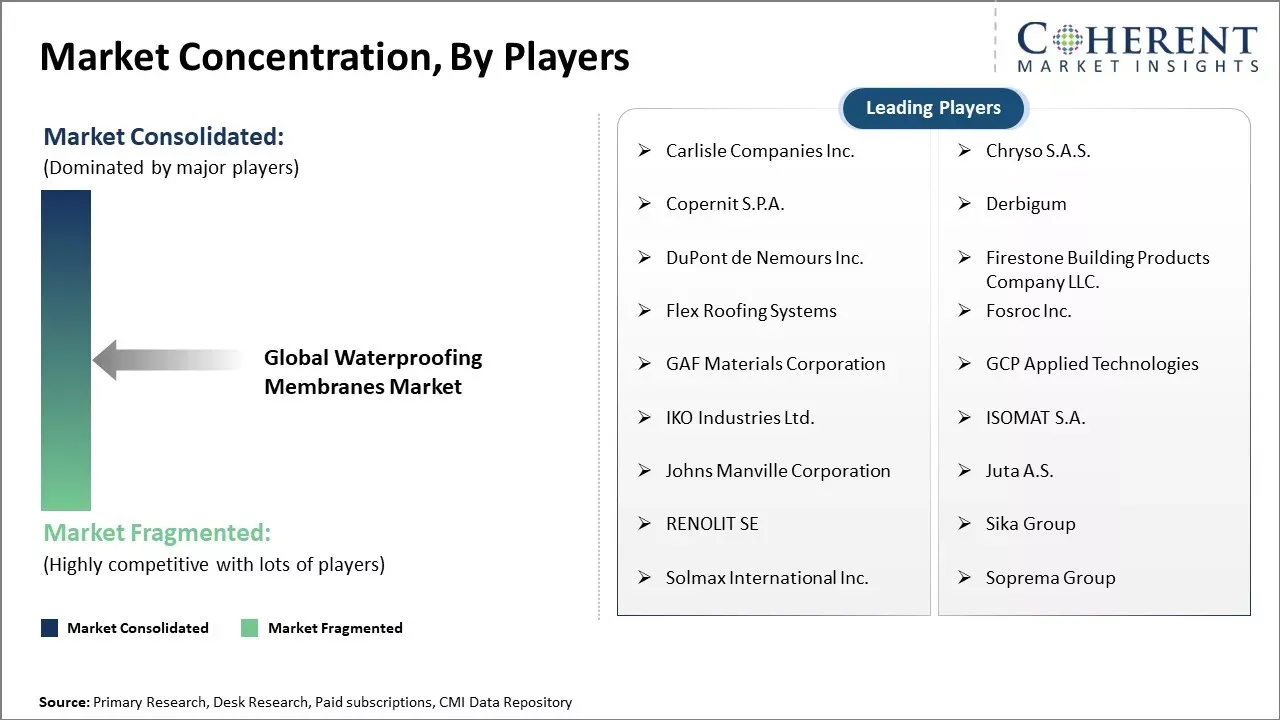The waterproofing membranes market is likely to surpass USD 28.78 Bn in 2025 and will reach USD 50.65 Bn by 2032, exhibiting a compound annual growth rate (CAGR) of 8.4% from 2025 to 2032.

To learn more about this report, Download Free Sample
Rapid infrastructure development is driving demand for waterproofing membranes. Residential and commercial construction spending is increasing worldwide. Awareness of green building materials is rising. Renovation and replacement activities are also increasing. There is a growing demand for eco-friendly and sustainable construction materials. These materials offer strong waterproofing protection.
|
Current Event |
Description and its Impact |
|
Global Supply Chain Disruptions and Raw Material Shortages |
|
|
Climate Change and Extreme Weather Events |
|
Uncover macros and micros vetted on 75+ parameters: Get instant access to report
Rapid urbanization is driving growth in construction worldwide. Demand for residential, commercial, and industrial projects has increased recently. Developing countries in Asia and Africa are seeing major investments in public infrastructure. Projects like roads, bridges, and dams are being built to support growing populations and industries.
Awareness about dry construction and long-term protection is growing. Governments are creating stricter rules for building waterproofing. Following these laws is now required to get construction approvals and certificates.
Liquid-applied membranes segment is likely to hold 69.0% of the market share in 2025. They are easier to use than other types of membranes. These systems come in one- or two-component forms. They can be rolled, brushed, or sprayed onto surfaces in liquid form and then left to cure.
For instance, in February 2022, Polyglass U.S.A., Inc., added PMMA (Polymethyl Methacrylate) liquid-applied waterproofing systems to its product offerings. This expands the company’s waterproofing range.
SBS bitumen will hold around 30.1% of the market share in 2025. It is known for its strong and durable waterproofing performance. SBS bitumen membranes use a flexible carrier mat filled with specially made SBS-modified bitumen.
For instance, Polyglass U.S.A., Inc. is known for its innovation in weather-resistant roofing and sealing. The company took part in the 2024 IIBEC Trade Show at the Phoenix Convention Center from March 8–11, at booth #417. It showcased new products that gained strong interest from commercial contractors. The use of SBS made the membrane highly durable, even in extreme temperatures.
Roofing and walls are likely to hold 31.6% of the market share in 2025. This is due to the large number of roofing installations worldwide. Most commercial and institutional buildings use waterproofed roofing systems. These range from low-sloped commercial membranes to steep-sloped residential asphalt shingles.
For instance, in November 2025, Siplast launched TeraPROOF, a full line of high-performance materials for below-grade use. The materials are designed to provide strong waterproofing for commercial buildings. This launch helped the company grow as a complete building enclosure protection provider.

To learn more about this report, Download Free Sample
North America holds the largest share of the global waterproofing membranes market. The region is likely to account for 39.2% of the market share in 2025. The region has an established construction industry with vast infrastructure. Buildings, parking structures, tunnels, basements, and bridges, which needs efficient waterproofing solutions.
For instance, in November 2022, Rotunda Capital Partners invested in U.S. Waterproofing, Chicagoland’s leading waterproofing and foundation repair company.
The Asia Pacific region is the fastest-growing market for waterproofing membranes. Rising populations and higher incomes are driving construction spending. Countries like China, India, and Indonesia are urbanizing quickly. This growth is increasing the demand for modern waterproofing methods.
For instance, in March 2023, Bostik India launched SEAL & BLOCK, the brand’s waterproofing solutions from basement to roof.
The U.S. will lead the global waterproofing membrane market in 2025. Strong construction growth drives this position. Rising infrastructure investments increase demand. Advanced technology enhances product quality. High awareness of building protection boosts adoption. Large commercial and residential projects raise sales.
For instance, in February 2025, Sika Corporation’s launched SikaShield branded Modified Bitumen roofing products. SikaShield is a new Hybrid membrane in the U.S. market.
China is likely to dominate the global waterproofing membrane market in 2025. This is due to rapid urbanization. Growing infrastructure projects increase demand. Rising construction activities boost sales. Government support drives market growth. Large-scale residential and commercial projects fuel adoption.
For instance, in July 2025, Nouryon launched an additive to help customers meet the latest performance standards in China. Elotex FX2325 was a redispersible polymer powder (RPP). It met the needs for membranes to bridge cracks in concrete under ceramic tiles.

To learn more about this report, Download Free Sample
Growth in construction activities in developing regions is boosting demand. Rising building and infrastructure projects in North America region offer major opportunities. Commercial and residential roofing remains the largest application.
Strict environmental regulations challenge manufacturers over certain chemicals. High production costs also limit market growth. Innovations that improve durability and reduce life cycle costs are key for adoption.
Liquid-applied membranes will grow faster than sheet membranes. Their single-component systems, quick application, and seamless installation appeal to users. North America currently leads the market and will continue to dominate. Asia Pacific and Europe are mature markets, but they will also see steady growth.
| Report Coverage | Details | ||
|---|---|---|---|
| Base Year: | 2024 | Market Size in 2025: | USD 28.78 Bn |
| Historical Data for: | 2020 To 2024 | Forecast Period: | 2025 To 2032 |
| Forecast Period 2025 to 2032 CAGR: | 8.4% | 2032 Value Projection: | USD 50.65 Bn |
| Geographies covered: |
|
||
| Segments covered: |
|
||
| Companies covered: |
Carlisle Companies Inc., Chryso S.A.S., Copernit S.P.A., Derbigum, DuPont de Nemours Inc., Firestone Building Products Company LLC., Flex Roofing Systems, Fosroc Inc., GAF Materials Corporation, GCP Applied Technologies, IKO Industries Ltd., ISOMAT S.A., Johns Manville Corporation, Juta A.S., RENOLIT SE, Sika Group, Solmax International Inc., Soprema Group |
||
| Growth Drivers: |
|
||
| Restraints & Challenges: |
|
||
Uncover macros and micros vetted on 75+ parameters: Get instant access to report
Emerging economies offer strong growth opportunities for the waterproofing membranes market. Over the next 30 years, more than half of the world’s population growth will occur in nine countries. Most of these are emerging markets.
*Definition: Waterproofing membranes are thin sheets made from materials such as modified bitumen, thermoplastic polyolefin, liquid-applied, and sheet-applied materials, which are used for waterproofing roofs and creating barriers to prevent leakage and seepage through building structures like foundations, basements, retaining walls, planters, and roofs. These membrane materials provide long-lasting protection against water infiltration and are designed to prevent moisture from damaging structures, materials and contents. The global waterproofing membranes market has been growing due to increasing construction activities and infrastructure development projects worldwide.
Share
Share
About Author
Vidyesh Swar is a seasoned Consultant with a diverse background in market research and business consulting. With over 6 years of experience, Vidyesh has established a strong reputation for his proficiency in market estimations, supplier landscape analysis, and market share assessments for tailored research solution. Using his deep industry knowledge and analytical skills, he provides valuable insights and strategic recommendations, enabling clients to make informed decisions and navigate complex business landscapes.
Missing comfort of reading report in your local language? Find your preferred language :
Transform your Strategy with Exclusive Trending Reports :
Frequently Asked Questions
Joining thousands of companies around the world committed to making the Excellent Business Solutions.
View All Our Clients